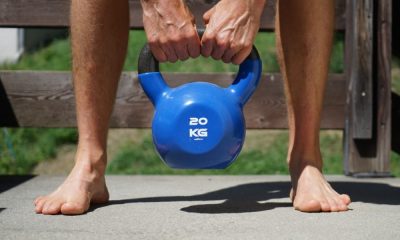
Everyone wants to do their utmost to recover and bring there best to the next session – but is icing post-exercise good for runners?
NOTE: This article was initially published in January 2018 and has had an update with a couple additional comments.
Not the sugary stuff on top of cakes, but submerging the body into ice cold water after exercise, on a regular basis, can aid recovery. For as long as I can remember world-class athletes have been using this technique to help recovery and reach new highs of athletic achievement.
It’s getting warmer in the UK right now and that cool dip or an an icy cold shower might seem a little more appealing.
Now there are people that saying icing is bad, mmmkay. So I figured it best to do a bit of research into the matter to try and see what the science actually says and what is the best protocol if you are using cryotherapy.
What’s been said before?
American running website, Competitor, had a piece back in 2015 and quite quickly concluded that science was on the side of icing. That article found three scientific studies that suggested icing reduced pain and therefore, it was good for runners.
A second glance at this fine piece reveals it is actually sponsored content paid for by the fine people at icesleeves.com. What possible bias could they there be with that?
Firstly, do we as runners need to reduce pain? Pain is the body’s way of communicating with us that rest is needed. That a muscle might need an easy day or two or that an injury is occurring.
If you’re a footballer in a big game or an ultra runner at the end of a long race then maybe reducing pain to get through to the end might be worthwhile (see the magic sponge). But is that a good thing after training, on a regular basis?
Hiding the pain
If you’re not listening to your body and masking pain then there could be health implications that won’t actually add to your long-term ability.
So what are we seeing as the potential benefits of icing? In one ingenious study athletes were asked to put one leg in an ice bath and keep the other outside of the cold water as a control measure. Whilst there may have been some cooling of the other leg because of blood flow, it was interesting to see that inflammation was reduced in the cold water leg.
So the reduction of inflammation is one suggested mechanism of improvement for icing, as well as others suggesting that the constriction of blood vessels caused by the cold water will “flush out all the bad stuff”. More on this later on.
Is inflammation the bad guy?
What we must now ask, is if inflammation is the Bond villain its made out to be? Why would the body do it, if it wasn’t a good thing? Maria Urso conducted a review of research in 2013 and found that the science was inclusive thus far. She determined further research was needed on the timing and benefits of icing on injuries and general recuperation. Inflammation may actually hinder recovery.
In 2006, Japanese exercise physiologist Motoi Yamane used cycling and hand grip exercises to measure the response to training effects with cold water immersion. The results actually found it did “seem disadvantageous for training, in contrast to the beneficial combination of rest, ice, compression and elevation in the treatment of macroscopic musculo-tendinous damage”. Good for acute injuries, not for training recovery.
The research is backed up by an Australian team from Queensland University, who found in 2014 that “regular cold water immersion attenuated improvements in strength and lean muscle mass following progressive high-intensity resistance training”. They advised that you should “therefore reconsider whether to use cold water immersion as a strategy to recover from exercise”.
Is it dangerous?

The case for cold water immersion isn’t looking good, for sure, but is there any risk in it (apart from the potential risk of it being counter productive above, obviously)? It works for world-class athletes like Paula Radcliffe, Jess Ennis and the Brownlee brothers, should we just be cracking on and taking ice baths just in case it’s going to make us better too?
A 2010 study, out of the University of Milan, looked into full body cryotherapy. This involved the whole body submitted to temperatures as low as −110°C to −140°C in special cryo-chambers and the team, led by Giuseppe Banfi, concluded that there was no risk if conducted correctly.
Another study, way back in 1992, by a team from Duke University led by Terry Malone looked at the risk of cold-induced peripheral nerve injury. They investigated “six cases of cold-induced peripheral nerve injury from 1988 to 1991 at the Sports Medicine Center at Duke University.”
The results found that although injuries could be severe, it was not a major risk as long as clinicians were “aware of the location of major peripheral nerves, the thickness of the overlying subcutaneous fat, the method of application (with inherent or additional compression), the duration of tissue cooling, and the possible cryotherapy sensibility of some individuals”.
Could age be a factor?
A study, using anti-inflammatory drugs instead of icing, looked at older athletes doing resistance training workouts. The study found that reduction of inflammation did increase muscle growth over the course of the research. Could the increased degradation of muscle at older ages mean that reduction of inflammation is more useful in masters athletes? More research is needed with regards to icing and this, but it shows a potential.
On the flip side, could a hot bath be of more use? Certainly more enjoyable, we’ll be investigating the benefits of hot baths and saunas in a future article with regards to recovery, heat adaptation and even performance enhancement. Is it better to gamble on a hot bath, rather than an icy one?
Hot and Cold
Could we even combine the two? Mixing hot and cold treatment post-exercise could aid recovery through vasodilation and vasoconstriction, creating the flushing effect that was discussed earlier as a reason for icing, but on an accelerated scale. Once again a 2004 review by David Cochrane was inclusive in it’s findings, especially when it comes to the effects on athletes.
When considering what the body’s physiological reactions are to both hot and cold water submersion, it certainly makes more sense that alternation would be the best option, but research into the effects is limited.
But if feels good
When we initially published this article Dr. Andrew Kirkland highlighted a flaw on Twitter. What if a cold river dip makes you feel better? How often do we hear “I only follow evidence based science”, which is all well and good as a 20-40 year old, recreational male in a mainstream sport, but half the science out there might not be suitable for you.
If you’re on a long run and there’s a chance to dip your head, or your whole body into a cold body of water at the end of it, does the psychological benefit come into play too? Mid run there might even be the effect of lowering your core body temperature too.
So although this article focuses on some of the studies out there, if it’s working for you then there is still a value there. It may be personal, placebo or just psychological, but it’s there.
Conclusion
Basically if you’re a regular ice bath user, read the above studies further to investigate whether what you’re doing is actually beneficial now, or if you will have to wait until you are older for the gains.
Are you considering cold water immersion for the first time? There could be better things to be doing post run, but if you try it and like a bit of ice, then have at it. Just don’t skip the basics, like a post workout refuelling, to sit in the freezer.
Want to run faster? For just £30 per month athletes are provided with a Final Surge plan for each day of the week, coaching advice from Robbie Britton and Tom Craggs, as well as access to the unique Fast Running Performance community.
If you would like more information on joining the project, click here.



















